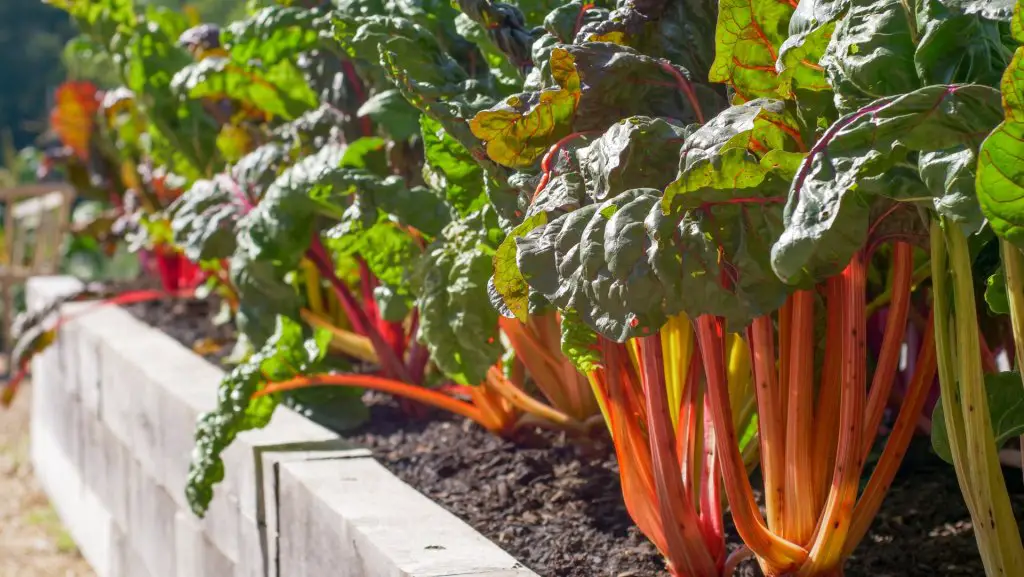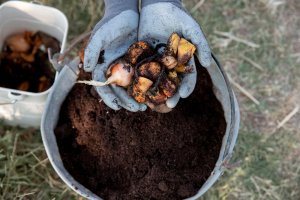Yes, you can compost rhubarb leaves. As for the toxicity of the rhubarb leaves, it quickly dissolves away, meaning your plants will be perfectly safe. Also, the rhubarb leaves make a good mulch for organic gardening.
When it comes to making a tasty rhubarb recipe, there’s only one condition: Don’t add the leaves to the dish. Only serve the rhubarb stalks, or else you may end up causing gastrointestinal problems to anyone eating the meal.
The reason for this is that the leaves contain excess concentrations of oxalic acid.
So, what do you do with the rhubarb leaves?
Think of something environmentally friendly, like making a compost pile.
Keep reading to learn how you can compost rhubarb leaves. We promise you, it’s going to be an easy DIY project.
Table of Contents
What To Know About Composting Rhubarb
For farmers who know the rhubarb plant well, the primary concern is how can poisonous leaves be used for mulching? Are there no side effects?
Amazingly, the rhubarb leaves have none. On the contrary, they’re a good source of nitrogen.
Plus, with rheum rhabarbarum ( another name for rhubarb), you do not need to add an activator to the compost bin. The whole plant quickly decomposes within 4-8 weeks.
Fortunately, the oxalic acid in the plant poses no danger to garden soil microorganisms. Once the plant decomposes, the acid breaks down and dissolves into the soil, reducing its ill effects on the microorganisms.
The oxalic acid also does improve the bioavailability of soil nutrients by regulating potassium levels in the soil. So, you can use rhubarb to make a compost heap.
Can You Compost Rhubarb Leaves?
Yes, you can compost rhubarb leaves. It’s a persistent garden myth that the leaves of rhubarb plants are dangerous when added to a compost pile.
If you haven’t done your research, it’s logical to assume a plant that’s poisonous to humans is also poisonous to other plants. It’s not true.
Even for mammals, the feared oxalic acid in rhubarb leaves is only a threat when consumed in large quantities.
We still eat it in other foods such as spinach, swiss chard, and even in tea and chocolate. The difference is that with rhubarb, the acid concentration is above human consumption.
Oxalic acid in rhubarb leaves is composed of Hydrogen, Oxygen, and Carbon, which are useful to any plant when it degrades in garden soil.
However, no damage can be done if the acid finds its way to the plant roots. This is because the acid molecules are large, and the roots can’t absorb them. So, either way, your plants are safe.
What’s more, the rhubarb leaves pose no threat to soil microbes. As a matter of fact, the microbes love it. For instance, earthworms have specific bacteria for digesting oxalic acid.
Adding rhubarb leaves to your compost does also improve the soil’s nitrogen.
Are Rhubarb Leaves Poisonous In Compost?
While rhubarb leaves are not poisonous in compost, you may want to have your gloves on when turning the pile or inspecting the compost. The juice from the rhubarb leaves can irritate your hands, which is due to the oxalic acid it contains.

However, they can be poisonous to plant-eating insects, which is an added advantage. Did you know you can make organic pesticides from rhubarb leaves?
Just crush the leaves, boil them in water, sieve the mixture, put it in a spray bottle, and voilà! Your homemade pesticide.
How To Compost Rhubarb Leaves in 5 Easy Steps
Composting rhubarb leaves is quite an easy DIY project.
Let’s first list what you need;
- Composting bin; you can purchase one or use that empty garbage bin in the garage
- Brown materials (We’ll discuss what they are in a few)
- Rhubarb leaves
- Water
The brown material supplies the compost with carbon. They can include shredded newspapers or wood chips.
A compost heap should offer two ingredients; Nitrogen and Carbon, that’s what makes it suitable for vegetable gardens. In our case, the rhubarb leaves will provide nitrogen.
Now, how do you compost rhubarb leaves?
Read the steps first before you mix.
Step 1
Place the brown materials and the rhubarb leaves in the composting bin. They should be in layers with even thickness.
The first layer should be the rhubarb leaves, then the brown material.
Step 2
As you fill each layer, make sure to water it. You need the layers to be damp. Use a sprayer to water, and DON’T overwater.
Step 3
Mix the materials. A pitchfork will do. Turn the matter or roll the bin forth and backward to mix.
Step 4
Ensure the compost is wet. Check whether you need to add water. Now the compost is ready, at least for the first stage.
Step 5
Turn the compost once every week. Also, ensure the compost is well moisturized. It should be damp.
Note
If the climate is hot, keep the compost under a shade to keep the manure from losing its nutrients.
Also, ensure the bin is well covered. You don’t want your compost to be a haven for ants and termites.
How Long Does It Take For Rhubarb Leaves To Compost?
You only need 6-8 weeks, and the compost should be ready. But with an activator, it will be less.
An activator can be a pinch of nitrogenous fertilizer. It simply hastens the multiplication of microbes and decomposition.
What Is The Best Compost For Rhubarb?

A simple compost bin will do for a small-sized backyard garden. However, if you’re doing large-scale farming, you need piles of about 3*3*3 square inches.
Also, the amount of rhubarb leaves in compost depends on the amount of manure required. The ratio should be 3-4 brown material to 1 part of green material.
So, Can You Compost Rhubarb?
It’s common for most farmers to be hesitant when it comes to composting rhubarb leaves due to their poisonous qualities. And while the oxalic acid from the leaves is indeed dangerous to human beings, it’s safe to compost rhubarb leaves.
Once broken down by the microbes, the acid increases the bioavailability of soil nutrients. It’s a compound of Hydrogen, Oxygen, and Carbon, so you don’t need to add a microbe activator to hasten the decomposition.
The whole plant takes only 6-8 weeks to decompose.

